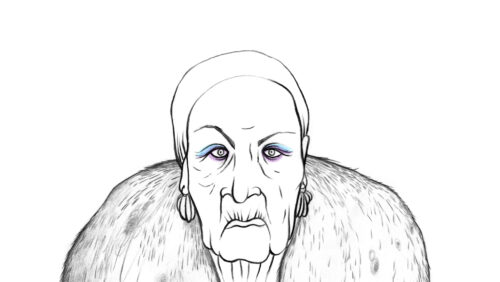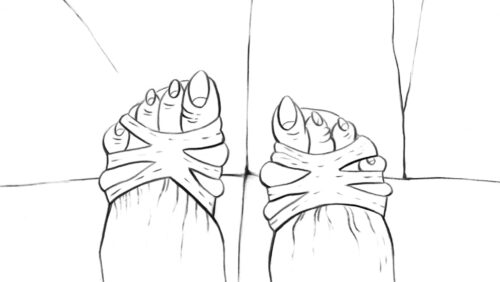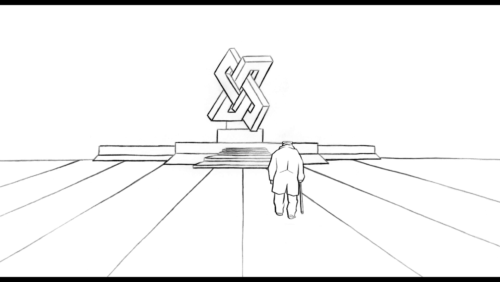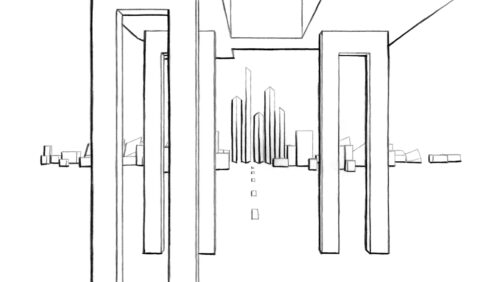Impossible Figures and other stories I
Marta Pajek
2021
| 16 min
Pencil on paper, digital 2D and 3D animation
Polish with English subtitles
Awards and Festivals
Official SelectionOttawa International Animation Festival, Canada (2021)
Special MentionBalkanima, Belgrade, Serbia (2021)
Golden Dove for the Best Short Animated FilmDOK Leipzig, Germany (2021)
Grand PrixAnimateka - International Animation Film Festival, Ljubljana, Slovenia (2021)
Prix de la VisionPIAFF - Paris International Animation Film Festival, France (2022)
Special award from Igor Grubic- Grand competition short filmAnimafest Zagreb, Croatia (2022)
Short CompetitionVilnius International Film Festival Kino pavasaris, Lithuania (2022)
Official SelectionGLAS Animation Film Festival, Berkeley, USA (2022)
Diploma of the jury - Profnastil - International competitionInsomnia International Animation Film Festival, Moscow, Russia (2022)
Official SelectionEncounters Short Film & Animation Festival, Bristol, UK (2022)
More Selections and Awards
An ominous ticking sound triggers a massive explosion. A swarm of objects and figures scatters unforgivably. In the aftermath, only a few souls remain, including an elegant elderly woman. Wandering deserted city streets, the tired, stoic woman painfully recalls what was and what could have been. As a flood slowly swallows the city, she shares a final moment of grieving beauty.
The final film (and first part) of Marta Pajek’s award-winning trilogy, Impossible Figures and other stories I is a mysterious and haunting portrait of personal and societal self-destruction.
Using striking black-and-white imagery and occasional brushes of colour, the acclaimed filmmaker directs this post-apocalyptic animated short with gentleness, compassion and a dash of hope.
Impossible Figures and other stories I is a co-production between Animoon and the National Film Board of Canada.
Two-liner
An ominous ticking sound triggers an explosion. Wandering deserted city streets, an elegant elderly woman recalls what was and what could have been. The final film (and first part) of Marta Pajek’s acclaimed trilogy, Impossible Figures and other stories I is a mysterious and haunting portrait of personal and societal self-destruction.
One-liner
Following an explosion, a mysterious and elegant elderly woman wanders deserted city streets, recalling what was and what could have been.
Long Synopsis
Something has ended, something else begins.
An ominous ticking sound triggers a massive explosion. A swarm of objects and figures scatters unforgivably. In the aftermath, only a few souls remain, including an elegant elderly woman. Wandering deserted city streets, the tired, stoic woman painfully recalls what was and what could have been. As a flood slowly swallows the city, she shares a final moment of grieving beauty.
The final film (and first part) of Marta Pajek’s award-winning trilogy, Impossible Figures and other stories I is a mysterious and haunting portrait of personal and societal self-destruction.
Using striking black-and-white imagery and occasional brushes of colour, the acclaimed filmmaker directs this post-apocalyptic animated short with gentleness, compassion and a dash of hope. A sensitive portrait of aging and mortality, Impossible Figures and other stories I is also a requiem for people who have lost touch, literally, with nature and each other.
Like parts II and III of this triptych, Impossible Figures and other stories I is based on the notion of an impossible figure—a figure that can be drawn according to the rules of perspective but cannot actually be constructed in the real world. While the previous films focused on a woman in the context of a home and in a relationship, part I explores a civilization, symbolized by the impossible figure of a once-flourishing but now vanishing city.
Impossible Figures and other stories I is a co-production between Animoon and the National Film Board of Canada.
Style and Animation Approach
Like the previous two parts of Marta Pajek’s acclaimed trilogy, Impossible Figures and other stories I is based on the notion of an impossible figure: a figure that can be drawn according to all the rules of perspective but cannot actually be constructed in the real world. The parts of the trilogy complement one another, within a box-like conceptual structure. Part I explores a city; part II a house; and part III explores the space between two people. These stories about impossible situations make use of paradoxes, illusions and traps.
The three films are also connected by their shared aesthetic: a unique blend of traditional and contemporary tools, a sense of movement influenced by dance, and a minimalist colour palette.
“I use 3D as a tool, aiming to blend it seamlessly with pencil drawing,” says Pajek. “It’s nothing especially original, but 3D allows me to create scenes that would be too complicated, almost impossible to create using only classical drawn animation, like the camera moving along corridors covered with patterned wallpapers, or the beast’s fur. But I want those scenes to be consistent with the rest of the film. I wouldn’t want the issue of technique to disrupt the watching of the film.”
When we think about animation, we inevitably think about colours, yet Pajek’s trilogy (and even her earlier student work) eschews colour in favour of a deceptively simple use of black and white, with rare moments of colour. “I’m not sure what black and white adds to the film,” says Pajek, “but there’s not much reason for colour in the story. Colour would only be a distraction, an unnecessary decoration.”
Pajek has long been inspired by dance. “It influences how I think about movement. I read something by Merleau-Ponty long ago, about a theory of the phantom limb, which made perfect sense in the context of cinema. I like the idea of our body playing a role not only in creating movement, but also in perceiving it through those phantom limbs.”
Director's Statement
Impossible Figures and other stories I is the final part of a triptych that deals with the paradoxes and illusions we encounter in various aspects of life. Each of the stories explores a different space. After the space between two people (Part III) and the space within a house (Part II), Part I takes the audience into a city. I decided that, contrary to its title, this film should be the last of the three to be made. I felt that I needed more time and experience to tackle a subject that goes so far beyond my own experience and knowledge—namely, the failure of utopias, the fall of our civilization, the end of humanity. It almost seemed arrogant to take on the subject at all. But the vision of the fallen city intrigued me. After all, I am one of its citizens.
I based the previous two films on my own experience, or what I noticed around me. I looked for movement in my own body, in the gestures and faces of people around me. This film required a different approach. I searched for inspiration among the fruits of the civilization I wanted to depict—architecture, sculpture, film. Those found bits and pieces helped me shape a city nearing its end, with all the young people gone and only a couple of old ones left wandering the streets.
During the process, I had the opportunity to spend time in cities that have been strongly marked by history—Warsaw, Vienna, Moscow. All of those places, with their grandiose architecture, museums stacked with artifacts, and painful pasts, inspired me and found their way into the film, whose protagonist is the city itself.
The first draft of the story was written together with the other two parts, but it evolved and ripened with time, during which I realized that eventually, just like the other two, this would be a film about what I don’t understand, rather than what I know. Rather than exposing faulty mechanisms, I aimed to get in touch with the fear of the inevitable end, and the frustration of one’s helplessness in the face of it.
Gradually, as I was developing the story, the reality around me seemed to adjust to that pre-apocalyptic mood. Part of the production was taking place in Montreal, in the old National Film Board headquarters, which was being slowly emptied and dismantled before the move to the new building. When I arrived, the enormous NFB logo (known as “man seeing”) had already been removed from the top of the building. It felt like the end of an era in filmmaking history—an era of geniuses like Norman McLaren, of room-size projectors, brilliant inventions, unique instruments like the pinscreen, of vaults and endless maze-like corridors. A reign of materials, objects and machines, but also of people and stories.
When the pandemic began, production was in full swing—we headed into isolation and switched to online meetings. Abandoned city streets became our everyday reality, and the confinement in one’s own home made it seem like the apocalypse was already creeping in on us. I had an uneasy feeling that the story we were telling wasn’t some far-fetched fantasy, but rather the world we suddenly woke up in.
We finished the film in a different reality than the one we inhabited when the story was first written. It is with much anxiety that I am sending this last part of the triptych into the world, but I hope it will resonate with audiences and that they find in it a note of consolation or strength that comes from connecting with one’s fears.
– Marta Pajek, June 2021
Trailer
Excerpts
Promotional Materials
Images
Loading...

Download
Loading...

Download
Loading...

Download
Loading...

Download
Loading...

Download
Loading...

Download
Team
Marta Pajek
Writer, Director and Animator
Photo
Photo : Zosia Zija and Jacek Pioro
Zofia Jaroszuk
Line Producer (Animoon)
Photo
Photo : Lukasz Murgrabia
Piotr Szczepanowicz
Producer (Animoon)
Photo
Photo : Lukasz Murgrabia
Grzegorz Wacławek
Producer (Animoon)
Photo
Photo : Lukasz Murgrabia
Maral Mohammadian
Producer (NFB)
Photo
Photo : © Maral Mohammadian
Michael Fukushima
Executive Producer (NFB)
Photo
Photo : David Fine
Credits
voice
Anna Polony
written, designed and directed by
Marta Pajek
producers
Piotr Szczepanowicz (Animoon)
Grzegorz Wacławek (Animoon)
Maral Mohammadian (NFB)
line producer
Zofia Jaroszuk
executive producer
Michael Fukushima
production manager
Karolina Sendecka
Martyna Siwińska
2D animation
Alex Boya
Eva Cvijanović
Parissa Mohit
Marta Magnuska
Małgorzata Mianowska
Marta Pajek
clean up and coloring artists
Anna Chrzanowska
Mateusz Frank
Marta Iwańska
Julia Kożuszek
3D animation
Brandon Blommaert
Kacper Czyczyło
Monika Kołcz
3D modelling and rigging
Tomasz Tomczyk
fur simulation
Grzegorz Flaga
rendering
Monika Kołcz
colour correction
Magdalena Kulak
scanning and retouching
Maria Pajek
compositing and editing
Marta Pajek
technical director
Eloi Champagne
technical coordinators
Randall Finnerty
Luc Binette
studio administration
Rosalina Di Sario
senior production coordinator
Dominique Forget
studio coordinator
Barry Ahmad
Faisal Moula
WHERE HAVE ALL THE FLOWERS GONE
performed by
Anna Polony
written by
Peter Seeger, Max Colpet
Courtesy of Schubert Music
original music
Aleksandra Gryka
additional music
Marcin Kuczewski
foley artist
Michał Jankowski / Noiseroom
foley recordist
Paweł Łuczak
sound design and editing
Michał Jankowski
additional sound design
Olivier Calvert
sound mixing
Piotr Knop / Toya Studios
Michał Jankowski
marketing
Judith Lessard-Bérubé
mastering and DCP
Marek Dudzik
A Polish Film Institute co-financed production
An Animoon and National Film Board of Canada co-production
Media Relations
-
Animoon
Animoon produces animated projects of high artistic and narrative quality, mainly based on original ideas.
Portfolio of the studio consists of short, and full-length animated films, and animated series, with projects dedicated to a wide audience – starting from the youngest, through teenage viewers, families and adults

Animoon works closely with executive producers who specialise in different animation techniques, thus the artistic variety of the studio’s portfolio. Animoon’s production are made thinking about viewers from Poland and from abroad. Each one of our projects is developed and promoted as a separate brand.
-
About the NFB
The National Film Board of Canada (NFB) is a leader in exploring animation as an artform, a storytelling medium and innovative content for emerging platforms. It produces trailblazing animated works both in its Montreal studios and across the country, and it works with many of the world’s leading creators on international co-productions. NFB productions have won more than 7,000 awards, including seven Oscars for NFB animation and seven grand prizes at the Annecy festival. To access this unique content, visit NFB.ca.